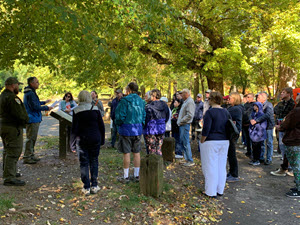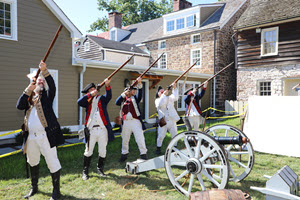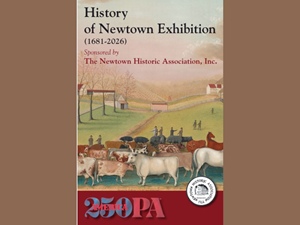About Edward Hicks
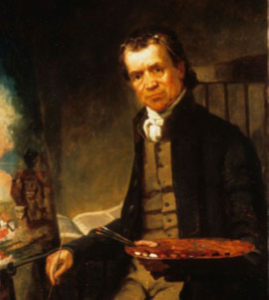 Edward Hicks (1780-1849), son of Isaac and Catherine Hicks, was a leading American folk artist, and the painter of the famous Peaceable Kingdom (Hicks painted over 100 different versions of this biblical scene). He lived in Newtown for almost forty years. Born in Langhorne, his mother died when he was only one year old and Hicks was raised in the Twining farm household in Newtown Township by David and Elizabeth Twining. After an apprenticeship in Attleborough (Langhorne), and an eleven-year stint as junior partner of a coach maker in Milford (Hulmeville), Hicks moved to Newtown in the spring of 1811 with his wife Sarah Worstall and his children to go into business for himself. He moved into the house with the brick front on Court Street near Tucker’s Tavern (the Court Inn), which he had bought from Abraham Chapman. He soon opened a shop in his back yard and carried on his business of coach and sign painting. A few months after this move he became a Friends minister.
Edward Hicks (1780-1849), son of Isaac and Catherine Hicks, was a leading American folk artist, and the painter of the famous Peaceable Kingdom (Hicks painted over 100 different versions of this biblical scene). He lived in Newtown for almost forty years. Born in Langhorne, his mother died when he was only one year old and Hicks was raised in the Twining farm household in Newtown Township by David and Elizabeth Twining. After an apprenticeship in Attleborough (Langhorne), and an eleven-year stint as junior partner of a coach maker in Milford (Hulmeville), Hicks moved to Newtown in the spring of 1811 with his wife Sarah Worstall and his children to go into business for himself. He moved into the house with the brick front on Court Street near Tucker’s Tavern (the Court Inn), which he had bought from Abraham Chapman. He soon opened a shop in his back yard and carried on his business of coach and sign painting. A few months after this move he became a Friends minister.
A major local concern of Hicks was the establishment of a Friends Meeting in Newtown. Eventually the meetinghouse was built on Court Street on a two-acre lot bought from Dr. Phineas Jenks. The first Preparative Meeting in the new house was held in 1817, at which Hicks was the first speaker. Through serving on Friends’ committees he became involved with the major social concerns of his day: peace, temperance, relations between the sexes, education, poverty and race relations. He sometimes worked as a janitor and grave digger. In 1821, Hicks built a stone house on present day Penn Street. He built his coach shop in the back yard, and his paint shop above the carriage house which adjoined his home. Neighborhood businessmen beat a path to the artist’s paint shop to order signs. The artist’s reputation spread state-wide. He resided in Newtown until his death in 1849 and he was buried in the Friend’s cemetery in Newtown.
From the Edward Hicks Room Collection, Newtown Historic Association
Penn’s Treaty Signboard – 1844
Samuel West, proprietor of Pennsylvania Arms commissioned Hicks to paint this sign in June 1844. The sign originally hung in front of the Washington House Inn, a temperance hotel, in Chester Pa.
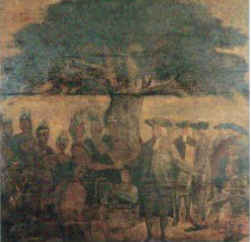
The elm tree in the middle is very unique because Hicks usually painted trees on the left. This may have been symbolic or for symmetry showing William Penn’s treaty with the Indians at Shacknaxon. The tree unites them.
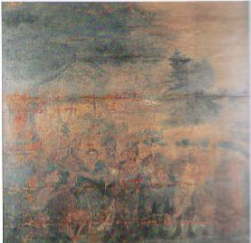
Painted on both sides, this side depicts William Penn’s landing at Chester. This side of the sign is badly weathered because it faced the direction of the elements. The paintings are oil on pine wood. The sign itself is made up of panels in a frame that can contract and expand easily.
Miniature Chest – c. 1835
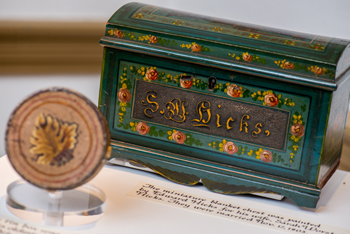
This blanket chest was decorated by Edward Hicks. He made it for his wife, Sarah Worstall Hicks. It was a wedding present, they were married on Nov. 17, 1803. Notice the decorative floral motifs that were very popular during the 19th century. (oil on wood)
Tin box – c. 1835
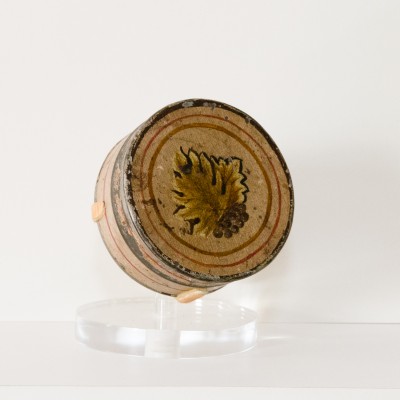
Edward Hicks decorated this box for his oldest daughter, Mary (Oct. 12, 1804 – Feb.7, 1880). She never married and thus had no heirs. (oil on tin)
Accounting Book – 1806 – 1833
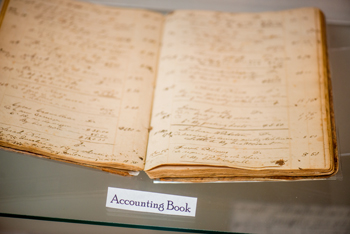
This book is where Edward Hicks entered the amounts he charged for simple jobs such as painting lettering on a sign.
Grindstone/Muller Stone
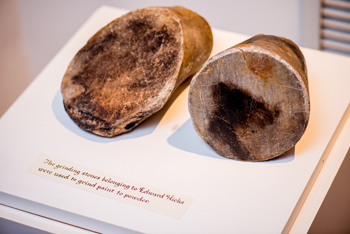
Edward Hicks used this stone to prepare dried pigments. This stone has burn marks from when his workshop caught fire in the early 1800’s. This workshop was located behind 107 Court Street.
T-Square – c. 1830
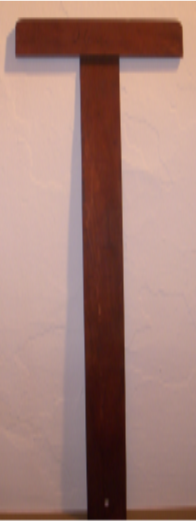
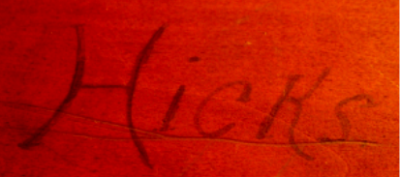
This t-square was used for drawing parallel lines. The t-square itself is unusual because it is thinner than modern t-squares.
Toleware Tray – 1815 – 1830
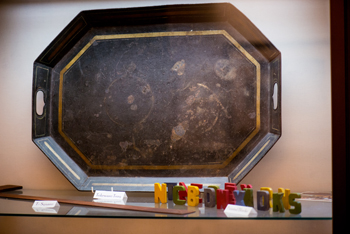
This is a tea serving tray painted by Hicks and used in his family home. (oil on tin)
Needle Case with Needles

This needle case and needles were used by Hicks for upholstery on the coaches he worked on.
Knives and Forks
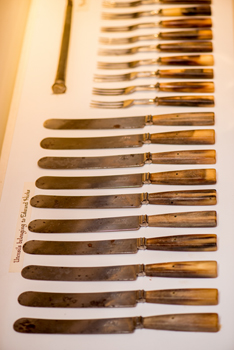
These utensils were owned and used by Hicks.
Rocking Chair – 1830 – 1845
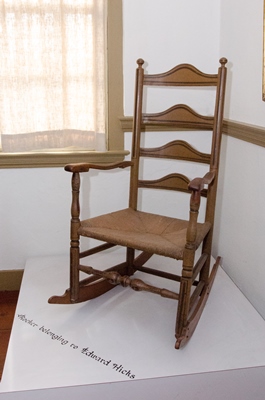
This Rocking Chair was owned and painted by Edward Hicks. The design is plain and simple to fit the décor of a Quaker house
Mortar and Pestle
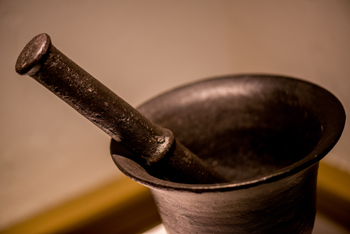
These tools were used by Hicks to grind paint colors into fine powder. 19th century, cast iron, unknown maker.
Stencil
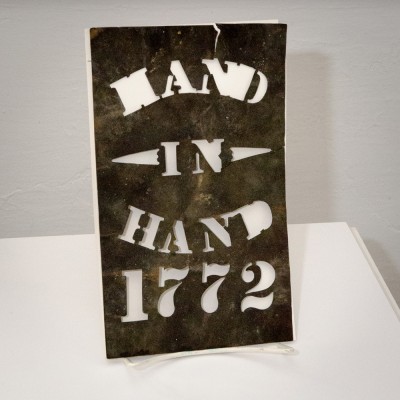
This is a tin Stencil used by Edward Hicks. It reads: “Hand in Hand 1772.”
Silhouette Picture
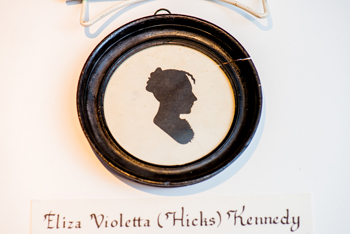
This silhouette is of Eliza Violetta (Hicks) Kennedy (March 17, 1778 – July 28, 1817), Edward’s sister. The artist is unidentified.
Painted Blocks
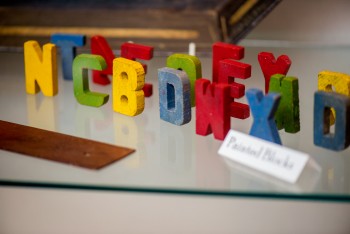
This is a set of 21 painted blocks. These blocks were made and painted by Edward Hicks. They were made to teach children numbers and the alphabet.


